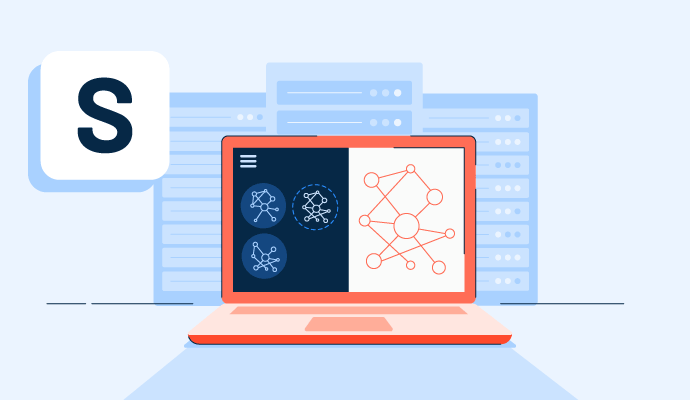What is SD-WAN?
A software-defined wide area network (SD-WAN) monitors, controls, and manages resources between remote branches and data centers. Engineers can control all wide area network (WAN) traffic through a single control point.
The conventional WAN function links users to applications hosted on servers in the data center. To help ensure security and reliable connectivity, it uses dedicated multiprotocol label switching (MPLS) circuits.
SD-WAN solutions have become popular with an increasing demand for quick, scalable, flexible connectivity across various network environments. Along with improving application performance, they reduce the total cost of ownership (TCO). TCO estimates expenses associated with purchasing, deploying, using, or retiring a product.
Many companies use SD-WAN software to seamlessly join enterprise networks to safely deliver applications and information.
SD-WAN features
SD-WAN offers a great user experience (UX) when connecting to the public cloud and SaaS applications through functionalities like:
- Application traffic control. SD-WAN technology can route application traffic over the most advantageous link type using multiple MPLS, broadband internet, cellular, and satellite connections. Applications that require a lot of bandwidth, like streaming or file sharing, deliver better performance.
- Better application control. SD-WAN can automatically detect and accelerate thousands of private and public cloud applications. It knows what level of quality of service (QoS) to apply and which WAN paths to choose. It also understands how to prioritize applications.
- Real-time routing judgments. As part of its packet-based approach to traffic handling and shaping, an SD-WAN solution can use inline and edge routing modes to insert services dynamically. As a result, it sends traffic over various bonded links, reducing jitter, latency, congestion, and packet loss for better performance.
- Thorough security. SD-WAN includes built-in security mechanisms like firewalls and intrusion detection and prevention systems (IDPS), along with integration with secure web gateway (SWG) vendors. This improves upon the performance-degrading backhaul necessary for security enforcement in traditional WANs.
- Automated cloud on-ramps. Cloud on-ramps based on SD-WAN offer direct, secure, and highly available connections between branch offices and infrastructure as a service (IaaS) or platform as a service (PaaS) clouds, as well as between various locations.
SD-WAN uses
While it’s primarily used for security, SD-WAN also serves a few other business purposes.
- Improved application experience. With less latency, better performance, and more dependable connectivity, SD-WANs make it possible for remote sites to connect more quickly to networks, data centers, or multiple clouds. An engaging UX can be the difference between success and failure, as users demand more from their applications and infrastructure.
- Immediate investment advantages. When the total cost of ownership is considered, MPLS and other connectivity technologies are outdated and expensive. In addition to significantly lowering bandwidth costs, SD-WAN consolidates various point networking and security products, reducing capital costs.
- Effective operations. The expansion of products used solely for networking and security has increased complexity as network infrastructures have transformed. SD-WAN uses automation to simplify connectivity across mixed environments, including on-premises, hybrid, and cloud. Centralized orchestration, zero-touch provisioning, analytics, and deep integrations of cloud on-ramps are all doable with SD-WANs.
- Improved security posture. Without integral security, SD-WAN solutions can turn into attack vectors. Secure SD-WANs provide private, direct internet access when adequately implemented. An SD-WAN tool guarantees constant security at all edges, from flexible WAN edges to cloud edges.
Components of SD-WAN
The SD-WAN architecture is made up of four key components.
- SD-WAN Edge is a physical or virtual network component installed at branch, regional, and central office locations and in data centers and public or private clouds.
- SD-WAN Gateway reduces service interruptions and shortens the distance to users or cloud-based services. The vendor of an SD-WAN service or the organization using the service may set up and maintain a distributed network of gateways. The gateways lessen traffic by remaining in the cloud away from the headquarters.
- SD-WAN Orchestrator enables configuration and provisioning. It simplifies application traffic management by centralizing an organization’s business policy.
- SD-WAN Controller forwards application flows or Internet Protocol (IP) packets related to a user application or a group of applications.
Advantages of SD-WAN
Enterprise, branch, and data centers were the only applications the conventional WAN architecture supported. When a company uses SaaS and IaaS cloud-based applications, the traffic caused by accessing programs around the world puts too much pressure on traditional WAN architecture.
Modern applications live on the cloud instead of traditional servers. WAN architecture inherently supports traditional networks, causing extensive stress on the network with the widespread adoption of SaaS and IaaS cloud-based applications.
- Enhanced routing and network management. SD-WAN provides security solutions, effective offloading of high-priced circuits, and WAN management simplification.
- Improved app experience. All critical enterprise applications will have high availability and predictable service with enhanced connectivity to the cloud.
- Multiple links. Hybrid active links are available for all network scenarios.
SD-WAN vs. traditional WAN
A traditional WAN network is based entirely on hardware network devices and relies on MPLS for effective network traffic flow. Various hardware devices and proprietary circuits are installed to route IP services to their intended clients.
The network requires multiple layers of installed hardware, so IT teams put a lot of effort into managing it. Scaling a traditional network is challenging because it requires advanced planning and network infrastructure.
With SD-WAN, a software tool manages everything, from connectivity to service delivery. It’s a virtual network strategy that combines broadband connections, MPLS, and long-term evolution (LTE), as well as established WAN technologies.
Global enterprises benefit from SD-WANs because they offer improved application performance, optimized cloud connectivity, and easier management.
Learn more about how WAN connects businesses to success.

Sagar Joshi
Sagar Joshi is a former content marketing specialist at G2 in India. He is an engineer with a keen interest in data analytics and cybersecurity. He writes about topics related to them. You can find him reading books, learning a new language, or playing pool in his free time.




















